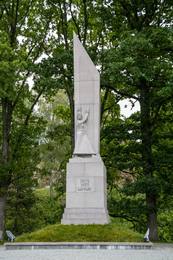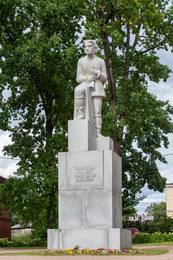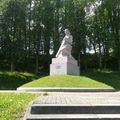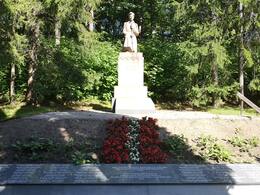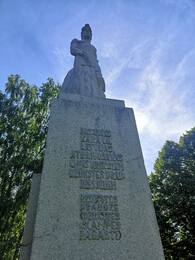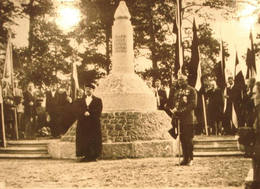Bildhauer Kārlis Zemdega (1894-1963)
II Zweiter Weltkrieg, IV Sowjetische Okkupation
Kārlis Zemdega (bis 1935 - Kārlis Baumanis) wurde am 7. April 1894 in der Pfarrei Cīrava geboren.
Studierte an der Cīrava Parish School und der Dunalka Primary School. Absolvent der Stadtschule von Aizpute. Er setzte seine Ausbildung an der Bloom School of Drawing und der Academy of Arts in Riga fort, wo er sowohl Bildhauerei als auch Zeichnen studierte.
1927 schloss er die Bildhauerwerkstatt unter der Leitung von Konstantin Ronchevsky mit dem Werk „Jakobs Kampf mit dem Engel“ ab. Danach arbeitete er weiter in der Werkstatt für Angewandte Bildhauerei, wo er die Techniken der Steinbearbeitung beherrschte. Aufgrund materieller Schwierigkeiten musste er als Angestellter und Zeichenlehrer ein Studiengeld verdienen. Er arbeitete als Lehrer an der Akademie der Künste - Leiter der Bildhauerwerkstatt (1940 - 1941), Professor (1947 - 1962) und arbeitete gleichzeitig auf Bestellung.
Kārlis Zemdega schuf den Rainis-Grabstein auf dem Rainis-Friedhof in Riga (1935) und ist der Autor des Rainis-Denkmals in Riga, Esplanade (1965 von den Bildhauern Laimonis Blumbergs und Aivars Gulbis gemeißelt). Er ist Autor mehrerer Denkmäler, die den Opfern des Ersten Weltkriegs und den Opfern des Unabhängigkeitskrieges gewidmet sind – in Koknja (1933), Vilaka (1935), den Gefallenen des Ersten Weltkriegs in Džūkste (1935), „Tālavas Trompeter" in Rūjiena (1937), Dobele-Befreiungsdenkmal (1939), "Koklētājs" in Talsi (entworfen von Vilnis Titans 1996 von Kārlis Zemdega). Das Denkmal „Sējējs“ in Rūjiena ist dem ehemaligen lettischen Ministerpräsidenten Arturs Alberings (1876-1934) gewidmet. Zemdega hat hauptsächlich monumentale Werke geschaffen, aber es gibt auch mehrere bedeutende Porträts und figurative Arbeiten in seinem Werk.
Kārlis Zemdega starb am 9. November 1963 in Rīga und wurde auf dem Rainis-Friedhof beigesetzt.
Im Haus des ehemaligen „Gaiļi“ in der Gemeinde Cīrava wurde 1975 ein Gedenkstein errichtet.
Weitere Informationsquellen
Bezogen auf Aizpute und Region. Biographisches Wörterbuch: http://vardnica.aizpute.lv/33-personas-z/670-zemdega-karlis
Vija Güne. Ich möchte große hellblaue Flügel: eine Version von Kārlis Zemdegu. Riga: Zvaigzne ABC, 1995.
Kārlis Zemdega. "And the strong will rise ..." Ingrida Buranes Konzept und Arrangement. Riga: Wissenschaft, 2019.
Zugehörige Objekte
Freiheitsdenkmal in Rauna
Das vom Bildhauer Kārlis Zemdega geschaffene Denkmal ist der Erinnerung an die Mitglieder der Gemeinde Rauna gewidmet, die im Ersten Weltkrieg und im Unabhängigkeitskrieg gefallen sind.
Als eine der nicht realisierten Varianten des Rigaer Freiheitsdenkmalprojekts wurde es am 20. August 1933 enthüllt. Der 3. Präsident der Republik Lettland, Alberts Kviesis, hatte an der Eröffnungsveranstaltung teilgenommen.
Der ursprüngliche Name des Denkmals war "ES DŪR" - das Motto - der Speer verwandelt sich in eine Cola und die Menschen werden durch den Geist des Liedes gerettet. Der Sockel des Denkmals ist mit den Worten der von Kārlis Baumaņi geschriebenen Hymne „Gott, heiliges Lettland“ geschmückt.
Vor der Enthüllung des Denkmals im Jahr 1933 pflanzten die Raunener bei der Dekoration des Denkmals eine Eichenallee und stellten unter jeder Eiche eine Kapsel mit dem Namen eines gefallenen Soldaten auf. Später, im Jahr 1937, wurden die Namen der Kämpfer auf einer weißen Marmortafel in der Kirche eingraviert.
Während der kommunistischen Besetzung wurde auf dem Sockel die Inschrift „Gott, heiliges Lettland“ eingraviert. Es wurde zu Beginn des Erwachens im Juni 1989 restauriert.
Denkmal „Herold von Tālava”
Das Hotel liegt am zentralen Platz von Rūjiena.
Das drei Meter hohe Bild eines alten lettischen Wächters, der in grauen finnischen Granit gemeißelt ist und „Tālava-Trompeter“ genannt wird, steht auf einem drei Meter hohen Granitsockel, aber die Gesamthöhe des Denkmals erreicht 7,5 Meter. In den ersten Skizzen und Modellen hatte K. Zemdega ihm ein Schwert in die Hand gegeben, das später durch eine Trompete ersetzt wurde. Das Denkmal wurde am 15. August 1937 enthüllt.
Dieses Denkmal spiegelt die schwierige Situation bei der Bildung unseres Landes und unserer Armee sowie bei der Bewertung dieser Ereignisse wider. Unmittelbar nach der Ausrufung des lettischen Staates marschierte die Rote Armee ein und die Übergangsregierung von Kārlis Ulmanis richtete in Liepāja eine Zuflucht ein. Im Februar 1919 begann mit Hilfe der estnischen Armee die Befreiung Lettlands vom Norden und die erste Mobilisierung in der Gegend von Rūjiena für die in Tartu gebildeten lettischen Truppen, die zur nordlettischen Brigade unter dem Kommando von Oberst Jorgis wurden Zemitaner. Die nordlettische Brigade kämpfte nicht nur gegen die Bolschewiki, sondern auch gegen die Landeswehr und die Eiserne Division in den Schlachten von Cēsis. Die Soldaten Nordlettlands, die in der Nähe von Rūjiena mobilisiert wurden, kämpften auch in den nachfolgenden Kämpfen des Unabhängigkeitskrieges. Nach dem Krieg wurden die Hauptlorbeeren von General Jānis Balodis und der von ihm kommandierten südlettischen Brigade gewonnen, aber er vergaß oft die nordlettische Brigade. Das in Rūjiena geplante Denkmal für Rūjiena wurde lange Zeit gebaut, und das 1937 enthüllte Denkmal wurde offiziell als Denkmal für die Befreiung von Rūjiena und das Gedenken an gefallene Soldaten populär gemacht, ganz zu schweigen von den Anfängen von alle Regimenter in Nordlettland.
Das Denkmal ist nicht nur eine beliebte Sehenswürdigkeit für lettische und estnische Touristen, die gewissermaßen ein Ausgangspunkt für den Besuch mehrerer anderer Gedenkstätten des Unabhängigkeitskrieges in Rūjiena ist, sondern „Tālavas taurētājs“ ist auch ein Zwischenstopp für estnische und Lettische Beamte verschiedener Ebenen.
Das Denkmal der Befreiung und der gefallenen Soldaten von Rūjiena, besser bekannt als „Talawa-Trompete“, wurde am 29.10.1998 in die Liste der staatlich geschützten Kulturdenkmäler als Kunstdenkmal von nationaler Bedeutung aufgenommen (Denkmalschutzregistrierung Nummer 4522).
Denkmal "Koklētājs" (Fiddler)
Das Denkmal "Koklētājs" in Talsi auf Ķēniņkalns ist dem Andenken an die Freiheitskämpfer gewidmet (Autoren K. Zemdega, Bildhauer V. Titans).Ende der 1930er Jahre beauftragte der Stadtrat von Talsi den Bildhauer K. Zemdega (1894-1963) mit der Herstellung des Denkmals. Im Jahr 1938 fertigte der Bildhauer ein Gipsmodell der Skulptur an, und eine Kapsel mit einer Botschaft an künftige Generationen über die Entstehungsgeschichte des Denkmals wurde auf dem Leči-Hügel vergraben. Der Zweite Weltkrieg machte dieser Idee ein Ende, aber der Abguss wurde versteckt und aufbewahrt. Mit der Wiedererlangung der Unabhängigkeit wurde die Idee, das Denkmal zu vollenden, wieder aufgegriffen. V. Titans beginnt im Museum für Agrartechnik "Kalēji" mit der Einmeißelung des "Koklētājs" in Stein. Das Denkmal wurde am 16. November 1996 in Anwesenheit des damaligen lettischen Präsidenten G. Ulmanis eingeweiht.
Friedhof der im Ersten Weltkrieg gefallenen Brüder in Tukums
Das Hotel liegt in Tukums, am Fuße des Sonnenhügels.
Das von Kārlis Zemdega geschaffene Denkmal „Schütze“ ist eines der letzten Denkmäler, das 1940 enthüllt wurde, bevor Lettland seine Unabhängigkeit verlor. Es zeigt einen jungen Soldaten, der kniet und seiner Heimat die Treue schwört. Am Fuße des Denkmals befindet sich der Brüderfriedhof mit mehr als 40 Bestattungen.
Während des Ersten Weltkriegs, als Kurzeme unter deutscher Besatzung stand, wurde an den Hängen von Pavārkalns ein Friedhof angelegt. Es gab Verschüttete, die von einem Bundeswehr-Militärgericht zum Tode verurteilt wurden. Die Bestattungen waren ursprünglich nummeriert und erst 1925 wurden die Identitäten aller Verurteilten festgestellt. Sie waren hauptsächlich gefangene Späher lettischer Schützen. Unter ihnen waren Zivilisten. Später wurden die Überreste des Volkes zusammen mit den gefallenen Soldaten der lettischen Armee an den Ort transportiert, an dem der Brüderfriedhof am Fuße des K.-Zemdega-Denkmals errichtet wurde.
Heute ist die Gedenkstätte zu sehen. K. Zemdega hat mehrere herausragende Denkmäler geschaffen, darunter das in Tukums.
Denkmal für die gefallenen Kämpfer des Ersten Weltkriegs in Džūkste
Das Denkmal für die Söhne der Dzukste- und Slampe-Gemeinden, die im Ersten Weltkrieg und in den lettischen Befreiungskämpfen getötet wurden, wurde am 17. November 1935 enthüllt. Der Autor ist einer der besten lettischen Bildhauer – Karl Zemdega.
Ein Denkmal zur Erinnerung an die Soldaten, die in den Kämpfen um die Befreiung Lettlands in Jaškov gefallen sind
Der Straßenabschnitt Viļaka – Vientuļi (P35) befindet sich auf der linken Seite der Straße, in der Nähe der Kapelle des Jaškova-Grabes.
Denkmal für lettische und estnische Soldaten, die im Unabhängigkeitskrieg starben.
Das 1920 vom Bildhauer Kārlis Zemdega geschaffene Denkmal zum Gedenken an die im Freiheitskampf in Jaškov gefallenen Soldaten wurde erstmals am 22. September 1935 an den 1929 errichteten Gräbern der Brüder Viļaka enthüllt.
Der Freiheitskampf gegen die Rote Armee in der Region Viļaka begann mit dem Angriff der lettischen Armee und des Partisanenregiments Lettgallen am 9. Januar 1920. Daran nahmen auch estnische Soldaten teil. Viļak wurde bereits am 9. Januar befreit, aber die Kämpfe östlich davon dauerten noch einige Tage. Sowohl vor als auch nach der Befreiung von Vilakas wurden die gefallenen Soldaten an verschiedenen Orten bestattet, die den Anwohnern bekannt waren. Als sich der Staat Lettland stabilisierte, begann Viļakas darüber nachzudenken, gemeinsame Gräber für Brüder einzurichten. Bereits ab dem 18. November 1923 zog nach einem feierlichen Gottesdienst in der katholischen Kirche, gehalten von Dechant P.Apšinīks, eine große Prozession zu der neu errichteten Grabstätte der Brüder auf dem Hügel, im sogenannten Jaškov – in unmittelbarer Nähe Umgebung von Viļaka. Bald wurde das Fundament des Denkmals gebaut, die Sammlung von Spenden für das Denkmal begann. Die Identifizierung der Gräber der gefallenen Soldaten dauerte einige Zeit, erst am 3. November 1929 fand die Umbettung in den künftigen Gräbern der Brüder statt. In ihnen wurden 31 lettische und 14 estnische Soldaten begraben, die in der Nähe von Viļakas gefallen waren.1935 war das Denkmal fertiggestellt und am 22. September wurde es feierlich eingeweiht.
In den Vorkriegsjahren der Unabhängigkeit Lettlands waren alle wichtigen nationalen Ereignisse in der Gemeinde Viļaka mit den Gräbern der Brüder und diesem Denkmal verbunden.
Das Denkmal wurde in den Nachkriegsjahren der Sowjetherrschaft zerstört, aber seine Granitteile blieben erhalten, obwohl sie beschädigt waren. Das Denkmal wurde am 11. November 1990, dem Lāčpleš-Tag, restauriert.
Zugehörige Geschichten
Freiheitsdenkmal Rauna oder Denkmal für die Mitglieder der Gemeinde Rauna, die im Ersten Weltkrieg und im Unabhängigkeitskrieg gefallen sind
Die Ursprünge der Idee des Freiheitsdenkmals von Rauna lassen sich auf den 21. Aufruf, den Erwerb der Freiheit zu ehren und in Rauna ein Denkmal zu setzen.







